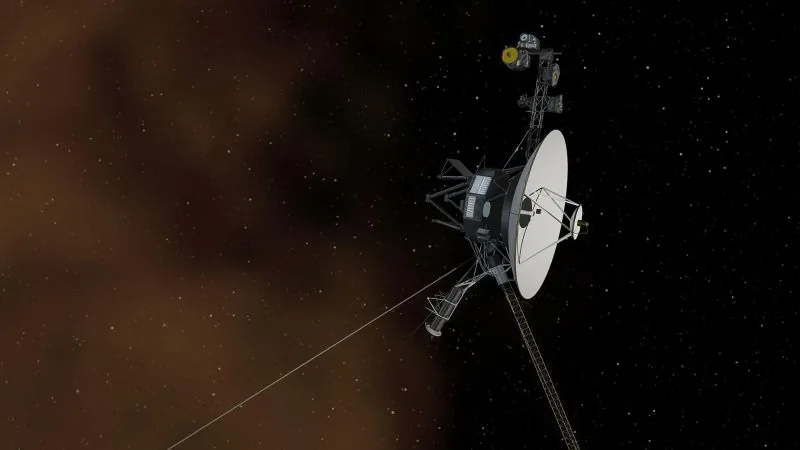
Voyager 1 Triumphs Over Clogged Thruster Challenge From 15 Billion Miles Away!
2024-09-16
Author: Ming
Introduction
In an incredible feat of engineering and creativity, NASA has successfully reignited a set of thrusters on the Voyager 1 spacecraft, which has been dormant for decades, to solve a critical issue threatening its ability to communicate with Earth from a staggering distance of 15 billion miles.
History of Voyager 1
Launched on September 5, 1977, Voyager 1's longevity far exceeded expectations, rendering it the most distant spacecraft from our planet. As it journeys beyond the heliosphere—the sun's protective bubble—this 47-year-old probe continues to send invaluable data about interstellar space back to Earth.
Challenges Faced
With time, however, the frigid conditions of deep space have taken their toll. Earlier this year, engineers at NASA's Jet Propulsion Laboratory (JPL) encountered a significant setback when a fuel tube in one of Voyager’s key thrusters became clogged. This malfunction posed a serious risk; without the capability to orient its antenna towards Earth, the spacecraft could effectively end its mission.
The Importance of Communication
The importance of maintaining communication cannot be overstated. Calla Cofield from JPL emphasized the potential disaster, stating, 'If the thrusters that keep the antenna pointed at Earth get clogged, that would be the end of the mission.'
Engineering Solutions
In a race against time, the engineering team devised a plan to command Voyager 1 to switch to an alternative set of operational thrusters. This was not without its challenges, as previous thruster issues had already surfaced in recent years. Voyager 1 possesses three sets of thrusters, each with unique roles, and it has switched between them to adapt to ongoing wear and tear.
Historical Maneuvers
The craft previously maneuvered using these thrusters during flybys of Jupiter and Saturn in the late 1970s and early 1980s. Now, with its trajectory set on a course away from the solar system, only one set of thrusters is needed to maintain communication. Unfortunately, as time has passed, clogs formed from silicon dioxide—a byproduct of aging materials in Voyager's fuel system—threatened functionality.
Current State of the Thrusters
NASA's trajectory correction thrusters were recently discovered to be in a state of severe clogging, with openings reduced to just 0.0015 inches—slender as a human hair. Having rotated through its previously functioning thruster sets, the urgency of switching to another became clear.
Innovative Solutions
The switch was complicated by the fact that energy conservation has led to nonessential systems—like heaters—being turned off, causing Voyager 1’s components to operate in colder temperatures. Engineers found an innovative solution by temporarily shutting down one of the main heaters to activate the thruster heaters, allowing for the crucial thruster switch.
Successful Reorientation
By August 27, Voyager 1 was successfully reoriented, marking a significant victory for the mission team. They have taken steps to use the thrusters sparingly to extend their lifespan, and current projections suggest that this set could continue functioning for an additional two to three years.
Future Operations
Moving forward, each decision regarding Voyager 1 will require meticulous analysis, according to Suzanne Dodd, the project's manager. Meanwhile, Voyager 2, which is also on a lengthy voyage away from Earth, has had its thruster issues but remains in better shape—having traveled over 12 billion miles.
Conclusion
The ongoing operations and discoveries from both spacecraft provide critical insights into our solar system and beyond, including the complex shield created by the heliosphere that protects Earth from harmful cosmic particles and radiation. Stay tuned as NASA continues to unravel the mysteries of deep space through these enduring probes!





 Brasil (PT)
Brasil (PT)
 Canada (EN)
Canada (EN)
 Chile (ES)
Chile (ES)
 España (ES)
España (ES)
 France (FR)
France (FR)
 Hong Kong (EN)
Hong Kong (EN)
 Italia (IT)
Italia (IT)
 日本 (JA)
日本 (JA)
 Magyarország (HU)
Magyarország (HU)
 Norge (NO)
Norge (NO)
 Polska (PL)
Polska (PL)
 Schweiz (DE)
Schweiz (DE)
 Singapore (EN)
Singapore (EN)
 Sverige (SV)
Sverige (SV)
 Suomi (FI)
Suomi (FI)
 Türkiye (TR)
Türkiye (TR)